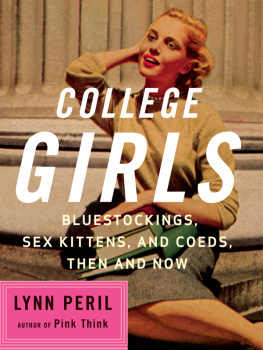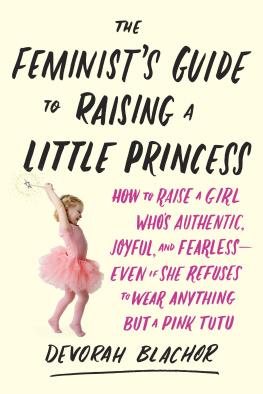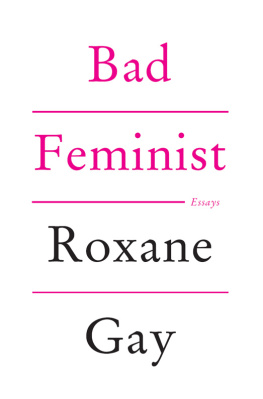

Copyright 2002 Lynn Payerl
Since this page cannot legibly accommodate all the copyright notices, Permissions/Illustration Credits constitutes an extension of the copyright page.
Portions of this book appeared in different form in Mystery Date,Hermenaut, and Spectacle.
All rights reserved
First Edition
For information about permission to reproduce selections from this book, write to Permissions, W. W. Norton & Company, Inc.,
500 Fifth Avenue, New York, NY 10110.
Book design by Rubina Yeh
Production manager: Amanda Morrison
Library of Congress Cataloging-in-Publication Data
Peril, Lynn.
Pink think : becoming a woman in many uneasy lessons / by Lynn Peril.
p. cm.
Includes bibliographical references.
ISBN 0-393-32354-4 (pbk.)
ISBN 978-0-39334-993-1 (e-book)
1. WomenSocialization. 2. Femininity. 3. FemininityHistory20th century. 4. Etiquette for womenHistory20th century. 5. PinkSocial aspects. I. Title.
HQ1221 .P445 2002
305.42dc21 2002070255
W. W. Norton & Company, Inc.
500 Fifth Avenue, New York, N.Y. 10110
www.wwnorton.com
W. W. Norton & Company Ltd.
Castle House, 75/76 Wells Street, London W1T 3QT
To Johnny
who taught me to believe in myself

Fortunately, I had a lot of support during the almost three years I spent working on this book. Many thanks to Johnny Bartlett, Katherine Cluverius, Catherine Coxe, Bob DOlivo, Karen Finlay, Rita Haskin, Timothy J. Halloran, Mary Ann Irwin, Eileen Lenihan, Jim Malloy, John Marr, Elizabeth McKenna, Donna Mae Mims, Mark Perelman, Mimi Pond, Mary Ricci, Chip Rowe, Jessica Rudin, Rich Stim, Deb Stoller, Jane Townley, Anne Treistman, V. Vale, Pete Wentz, Michele Lee Willson, Tomiko Wood, Michael Zadoorian, the librarians at San Franciscos Mechanics Institute Library and the Minneapolis Public Library, Dennis Preisler at the Sears Archive, Mickey McGowan at the Unknown Museum, Ron and Maria at Kayo Books, all the gals at the Ladies Lit List, and everyone in the Payerl/Voorhorst/Komie/Bartlett clansespecially my very patient mom!
Id like to thank loyal Mystery Date readers everywhere. You dont know how much your support has meant to me over the years. I especially appreciate the items of femoribilia many of you have donated to my collectionthey helped form the basis of this book.
Joshua Glenn, editor of Hermenaut, has not only supported my writing at every turn but also suggested I contact Alane Mason at a particularly dire point in Pink Thinks protracted gestation.
At a time when a handful of multinational megacorporations are changing the face of the publishing industry, I am proud to claim one of the remaining independents as my publisher. At W. W. Norton, Alane Mason and her assistant, Stefanie Diaz, provided insightful editorial input as well as boundless enthusiasm for this project. They made me write a better book, and I am profoundly grateful to them both.
Finally, Pink Think really would not exist without the efforts of Faye Bender, cheerleader, friend, and agent extraordinaire. All writers should be so lucky.


Long before its time for Mom to help plan the wedding dress or Dad to give the bride away, its time to be raising a future wife in your home. Because wives arent bornthey are made. Your daughter is born a female, but shehas to learn how to be feminine.
Constance J. Foster,
Raise Your Girl to Be a Wife,
Parents magazine, 1956
T he full-page ad that graced womens magazines in 1958 was so discreet as to be mysterious: a pink-suited socialite posed atop San Franciscos Russian Hill, while her servants carried a bevy of pink gift-wrapped boxes from her car to her fashionable apartment building. Pink is a very special mood read the large and flowing type beneath the picture. One had to investigate the smaller print to discover that the ad was for Serena, the luxury sanitary napkin by Modess. In addition to its other fancy attributes, Serena was softly pink to please the most discriminating woman, its pastel color as much an homage to femininity as the use to which it was put. Serena was not the only pink pad to grace drugstore shelves: the soft pink covering on Kotexs Miss Deb napkins made sixties-era preteens feel feminine and daintyjust the way a young lady wants to feel.
With such strong associations between femininity and the color pink, it may come as a surprise to discover that pink was not originally considered a girl color at all. Until the nineteenth century, most babies wore white; and if baby clothing incorporated color, boys were just as likely to wear pink as girls. The identification of girls with pink and boys with blue was apparently a French innovation, the exact origins of which remain unclear.1 It soon found its way into popular culture on this side of the Atlantic, however. In 1868, Louisa May Alcott included a scene in her phenomenally successful novel Little Women wherein Amy March (the artsy sister, remember?) puts a blue ribbon on the boy and a pink on the girl, French fashion, to differentiate between newborn twins.2 But color-coding babies pink and blue according to their gender didnt become widespread until the postWorld War II baby boom, when the arbitrary color assignment of a century or so before turned into a new mass habit and established a modern fact. By the time a 1952 series of poise and beauty booklets called The Charming Woman urged readers to Ask yourself why a baby has to wear pink and blue, its answer suggested that the conflation of color and gender sprang directly from the womb: [T]hese are the young delicate colors which actually look like the baby.3
Theres more to the story of pink than baby booties and blankets. A 1948 fad among coeds for pink Brooks Brothers shirts assumed such proportions that a year later the venerable menswear retailer began manufacturing a version specifically for women. The new shirt was only slightly modified from the original (or, as a New Yorker article smirkingly noted, the body of the shirt isahfuller) and immediately clicked with the college crowd.4
The shirt craze was just the tip of the iceberg, however. The sight of so many girls and women clamoring for that particular item, cash clenched in sweaty fists, buoyed the hope of manufacturers everywhere. Then again, maybe we were simply a nation literally in the pink with postwar prosperity, giddy that the war was over and ready for some serious shopping. Responding to the resounding demand of consumers, pink products became more and more visible in magazine ads and on the shelves of all manner of stores. Did you want to coordinate an outfit around your Brooks Brothers shirt? Start from the inside out with a Playtex Pink-Ice girdle, packaged in a slim, shimmering pink tube. It was guaranteed to be both cool as a frosty drink and invisible beneath your briefest swimsuitthough a look at the size of the garment quickly confirms that brief was a relative term. Were you tired of your antiseptic hospital-white kitchen and bathroom? Then the newly popular pastel lines of appliances and plumbing fixtures were for you! Little did pink-crazed shoppers realize theyd actually been available since the late 1920s.
Next page














